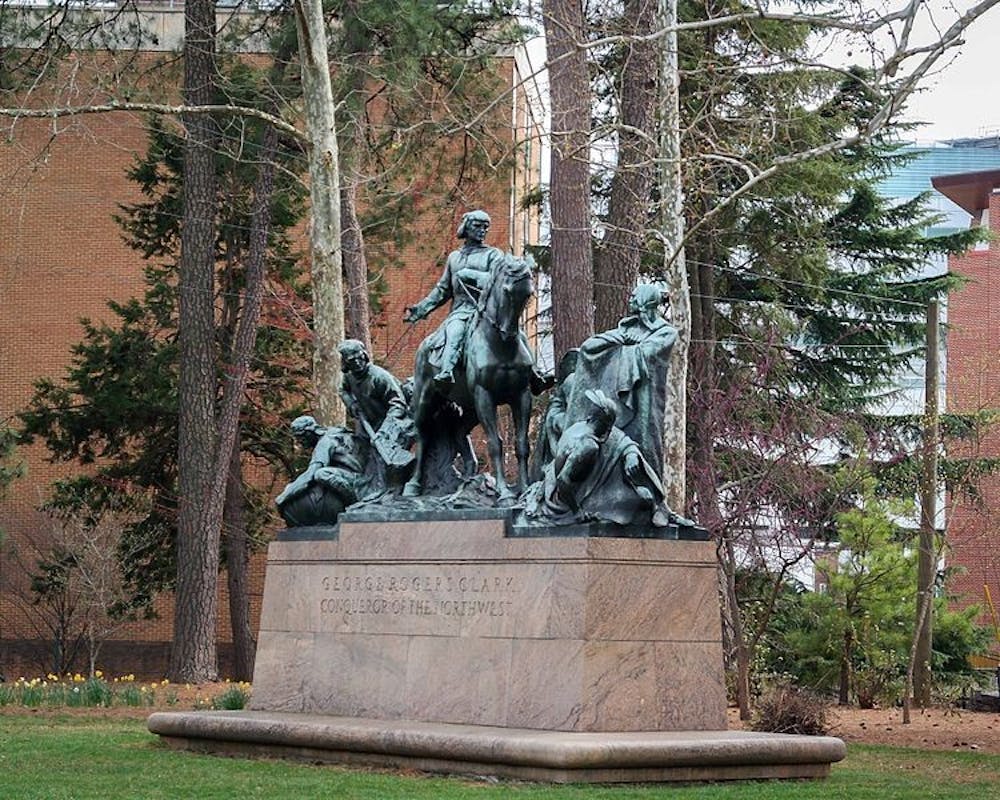The future of a monument depicting Revolutionary War general George Rogers Clark as the “Conqueror of the Northwest” is currently being discussed by the University’s Commission on the University in the Age of Segregation.
In November, the George Rogers Clark statue, which depicts the general on horseback confronting a group of Native Americans, was found vandalized. Two days prior, the Charlottesville City Council passed a resolution to remove a statue depicting Lewis, Clark and Sacagewea, following a discussion with members of the Shoshone-Bannock tribe and Monacan Indian Nation.
The University has the power to make decisions regarding the George Rogers Clark statue because it is located on University grounds.
“I want to see it removed,” said Anthony Malabad, a fourth-year College student and president of the University’s Native American Student Union. “This is less of a monument to George Rogers Clark and more of a monument of the forcing out of the Shawnee from their homeland.”
Deputy University Spokesperson Wes Hester declined to give an official University statement on the monument and said that the Commission on the University in the Age of Segregation has been tasked with considering the matter and making recommendations. This commission, which includes faculty, staff, students and members of the Charlottesville and greater Albemarle communities, was created in February 2018 by former University President Teresa Sullivan in the aftermath of the violent white nationalist rallies in Charlottesville.
“Although the commission … is not in a position to represent the University’s policy here, I do think there’s a general consensus by the commission that the George Rogers Clark monument is one that should … top any list for removal or recontextualization,” said Kirt von Daacke, an assistant dean of History and co-chair of the Commission on the University in the Age of Segregation.
The commission is not responsible for any final decision making, but is responsible for research, advocacy and making recommendations to University President Jim Ryan. A local petition started by activist David Swanson, currently with over 580 signatures, calls for the removal of the statue, and was passed on to the commission for consideration in August.
“Our memorialization working group is working on a set of guiding principles for how we consider each individual monument or building and how we might proceed with recontextualization, removal or re-naming,” von Daacke said.
Decisions to remove other controversial monuments have taken place this year at the University of Mississippi and the University of North Carolina. Both monuments pay homage to confederate figures, similar to the statues of Robert E. Lee and Thomas “Stonewall” Jackson located in Charlottesville.
“Everyone knows the Lee and Jackson statues, but the George Rogers Clark statue and the Lewis, Clark and Sacagawea statues are not as prominent,” Malabad said.
Despite the smaller level of public awareness about the George Rogers Clark statue, Malabad said it sends a clear message to Native students.
“Coming up from downtown … the first thing people see is this monument to westward expansion and genocide,” Malabad said. “It reinforces this idea that Native students are not welcome here, that University of Virginia is a whites-only space.”
The statue was added to the National Register for Historic Places in 1997. In the nomination form for this designation, the statue was described as an “important art object [that] retains its historic integrity of location, design, setting, materials, workmanship, feeling and association.”
According to von Daacke, the commission tasked with discussing the future of the statue is “in the midst of research and deliberation” and plans to publish an article about the dedication of the monument in the commission’s UVA Today series.
According to Malabad, “All of the Native students are pretty much convinced that the statue needs to go.”







